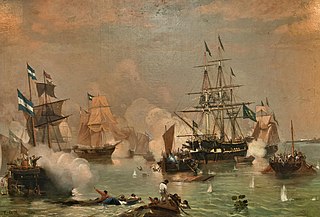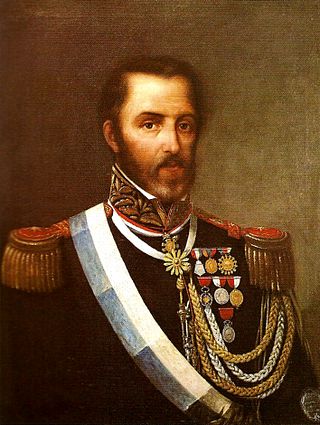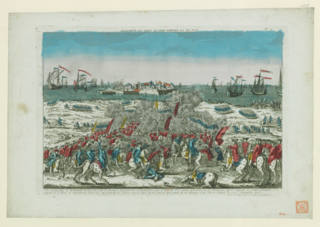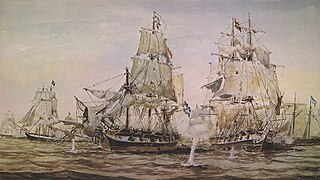
The Battle of Caseros was fought near the town of El Palomar, Argentina, on 3 February 1852, between forces of the Argentine Confederation, commanded by Juan Manuel de Rosas, and a coalition consisting of the Argentine provinces of Entre Ríos and Corrientes, the Empire of Brazil, and Uruguay.

In the Paraguayan War, the Battle of Yatay was fought on August 17, 1865, between the troops of the Triple Alliance and the soldiers of Paraguay near Paso de los Libres, Corrientes, Argentina.

The Cisplatine War was an armed conflict fought in the 1820s between the Empire of Brazil and the United Provinces of the Río de la Plata over control of Brazil's Cisplatina province. It was fought in the aftermath of the United Provinces' and Brazil's independence from Spain and Portugal, respectively, and resulted in the independence of Cisplatina as the Oriental Republic of Uruguay.

The Battle of Ituzaingó, also known as the Battle of Passo do Rosário, was a pitched battle fought in the vicinity of the Santa Maria River, in a valley of small hills where a stream divided the valley into two.

The naval Battle of Monte Santiago was fought on 7–8 April 1827, between the Argentine Navy and the Imperial Brazilian Navy, during the Cisplatine War. It was a decisive Brazilian victory, with the allied forces losing its best ships. The battle is highlighted by Argentine historians as one of the most courageous and ferocious naval encounters in the country's history. On that day, Captain Francis Drummond died on deck, firing his marooned ship's cannons instead of retreating.

Juan Galo Lavalle was an Argentine military and political figure from the Unitarian Party.

The Battle of Cerro Corá was the last battle of the Paraguayan War, fought on 1 March 1870, in the vicinity of Cerro Corá, 454 kilometres (280 mi) northeast of Paraguay's capital Asunción. It is known for being the battle in which Francisco Solano López, Paraguayan president, was killed at the hands of the Imperial Brazilian Army.

The Spanish–Portuguese War (1762–1763) was fought as part of the Seven Years' War. Because no major battles were fought, even though there were numerous movements of troops and heavy losses among the Spanish invaders, the war is known in the Portuguese historiography as the Fantastic War.

Manuel Marques de Sousa, Count of Porto Alegre, nicknamed "the Gloved Centaur", was an army officer, politician and abolitionist of the Empire of Brazil. Born into a wealthy family of military background, Manuel Marques de Sousa joined the Portuguese Army in Brazil in 1817 when he was little more than a child. His military initiation occurred in the conquest of the Banda Oriental, which was annexed and became the southernmost Brazilian province of Cisplatina in 1821. For most of the 1820s, he was embroiled in the Brazilian effort to keep Cisplatina as part of its territory: first during the struggle for Brazilian independence and then in the Cisplatine War. It would ultimately prove a futile attempt, as Cisplatina successfully separated from Brazil to become the independent nation of Uruguay in 1828.

The Portuguese invasion of the Banda Oriental was a short-lived and failed attempt, beginning in 1811 and ending the following year, by the Portuguese Empire to annex the remaining territory of the Spanish Viceroyalty of the Río de la Plata.

The Battle of Sarandí was fought on 12 October 1825, in the vicinity of the Arroyo Sarandí in Uruguay, between troops of the Banda Oriental and the Empire of Brazil. It resulted in a decisive victory for the Orientals.

The Battle of Paso de Patria was a battle of the Paraguayan War, which took place between April 16 to 23, 1866, on the banks of the Paraná River, in the then fortified position in Paso de Patria, in which the Empire of Brazil emerged victorious. It took place simultaneously with the Battle of Itapirú, during the so-called "crossing of the Paraná River".

The naval Battle of Quilmes took place between a fleet of the Imperial Brazilian Navy, commanded by British admiral James Norton and a fleet of the United Provinces of the Río de la Plata under the command of William Brown. The confrontations began at dawn on July 30, 1826 and lasted for three hours.

The Battle of Azenha Bridge was the first battle of the Ragamuffin War, which took place on the night of the 19th to the 20th of September 1835. It gave way to the capture of Porto Alegre by the rebels on the following day.
The Battle of Miranda was the final battle of the Paraguayan War between Brazilian and Paraguayan soldiers from April 4 to 8, 1870 before the final organized Paraguayan force surrendered.
The Battle of Yerbal, also known as the Battle of Erval or Battle of Pedras Altas, was fought on 25 May 1827 between a militia force of the Imperial Brazilian Army and an Argentine cavalry detachment in the context of the Cisplatine War.

The battle of Colonia del Sacramento consisted of a series of failed attempts made by admiral William Brown of capturing the town of Colonia del Sacramento, which was under Brazilian control and being sieged on land by insurgent Uruguayan forces, in the context of the Cisplatine War between the Empire of Brazil and the United Provinces of the Río de la Plata. The confrontations began in the morning of 26 February 1826 and ended on 14 March 1826.

Dom Afonso was a steam frigate that served the Imperial Brazilian Navy, being the first steamship to serve in this navy. It was built in England under the supervision of chief of squad John Pascoe Grenfell and was named Dom Afonso in honor of Afonso, Prince Imperial of Brazil, son of emperor Pedro II of Brazil and empress Teresa Cristina.

The assault on the battleship Barroso and the monitor Rio Grande, also known as assault on the battleships at Tagy, was a Paraguayan naval operation carried out during the Paraguayan War. The Imperial Brazilian Navy was present in the main actions of the allied forces. President Francisco Solano López knew of the threat that the navy posed and wanted to capture some of its ships, the ironclads. The seizure was also seen as a form of compensation for the losses incurred as a result of the war. Assault plans were created and executed in 1868.

The capture of Porto Alegre was one of the starting points of the Ragamuffin War. It took place on 20 September 1835, the day after the Battle of Azenha Bridge. Its date has been celebrated as a state holiday in Rio Grande do Sul since 1995 and also marks the end of Farroupilha Week, between the 14th and 20th of September.

















